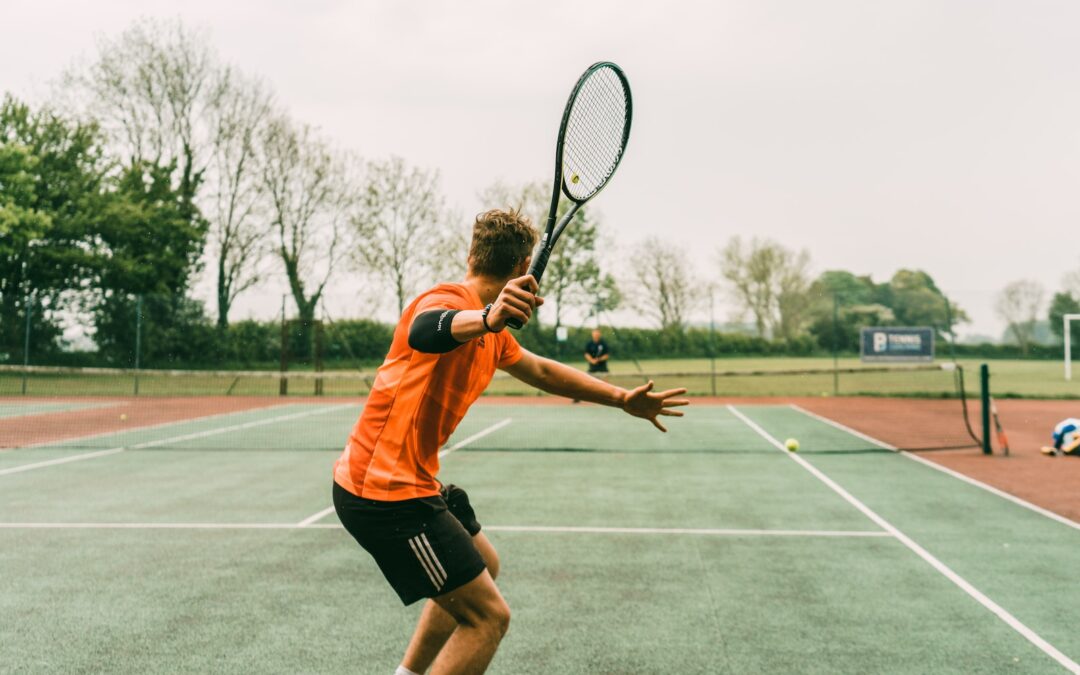The Importance of Shoulder Health and Tennis
When talking about important body parts for a tennis player, obviously the shoulders come top of the list! The shoulder is a complex joint, with lots of surrounding structures to potentially injure, so the health of your shoulders are very important when playing tennis.
With the overhand and underhand components of tennis, both mobility of the shoulder and strength and stability of the shoulder and scapula are equally important. If either mobility or strength and stability are not at the optimum level, the joint and surrounding might not be robust enough to take the stress of the repetition of tennis and over time, injuries can occur. The shoulder girdle is so heavily relied on during play.
The shoulder girdle consists of the ball and socket joint, scapula, humerus, and clavicle. The important muscles that we rely on to move and support the shoulder joint are; Deltoids, Pectoralis, rotator cuff (Supraspinatus, infraspinatus, Teres minor, and Subscapularis) & Rhomboids. These muscles help stabilize and move the joint when under load during tennis.
Some of these muscles are commonly known as the rotator cuff muscles. These are especially important for shoulder health when playing tennis. They are there to provide stability to the shoulder joint. The rotator cuff is made up of 4 main muscles which each have a slightly different role in maintaining the health and function of the shoulder when playing tennis;

Supraspinatus – Holds your humerus in place and provides stability for the arm (overhead, ball contact) It also helps lift your arm.
Infraspinatus – Enables rotation (External rotation) and extension of the shoulder (Serving)
Teres Minor – Assists in rotation (External rotation) away from your body (Backswing, Serve Preparation)
Subscapularis – Holds the upper arm bone to the shoulder blade. It assists in the movement of the shoulder joint, arm Rotation (Internal rotation), and moving the arm up and down.
These muscles can be strengthened and activated individually to provide specific muscle activation, or as a general group to provide general stability and strength. The rotator cuff muscles are very small in comparison to some of the bigger muscles around the shoulder, and because of that, they can become weak and underactive because the bigger muscles can overwork and become more dominant in providing strength and stability to the shoulder. As a result of this, they can become fatigued and become a weakness when on court, either training or playing.
It is very important to strengthen them regularly, to help to increase the strength in them and prevent any imbalances within the scapula and shoulder joint. It is ideal to strengthen these muscle 3 or 4 times a week to provide enough activation.
Below, are a few exercises that can be useful for strengthening this muscle group and providing additional stability to the joint.
SHOuLDER STRENGTH & FuncTION EXERCISES
EXERCISE #1: BANDED INTERNAL ROTATION
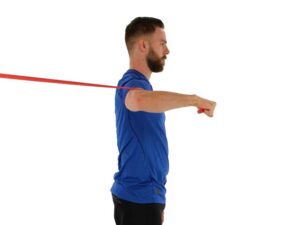
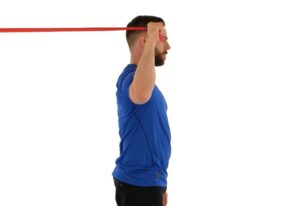 To do this, tie an elastic behind you at head level and hold it with your hand.
To do this, tie an elastic behind you at head level and hold it with your hand.
Raise your arm to 90 degrees apart from your body and pull the tip of your shoulder backward while you pull the elastic forward in a rotating motion, keeping your elbow still.
Raise your hand slowly and repeat.
EXERCISE #2: WEIGHTED EXTERNAL ROTATION
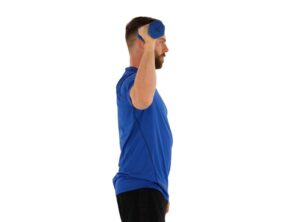
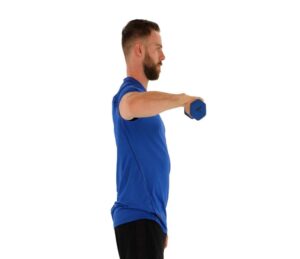
To do this stand up with a weigh in your hand. Keep a 90/90 position (shoulder at 90 degrees to the body and elbow at 90 degrees) and lift the weight up by doing an external rotation without moving the elbow.
Slowly lower your hand and repeat.
EXERCISE #3: PNF Diagonal
Alongside strengthening the rotator cuff muscles a function exercise that can mimic the tennis stroke can be good. This will help to provide strength and stability at different ranges of motion during the tennis serve and can make the shoulder more robust for your game. A PNF Diagonal is a great example of this!
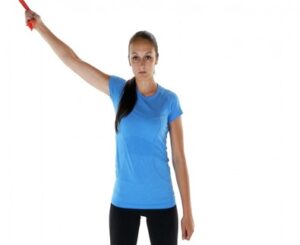
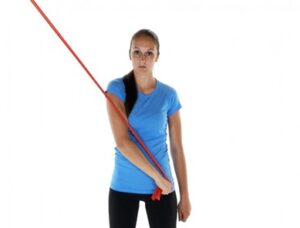
This can be done either using a hand held weight or a resistance band.
To do this, In standing, attach a resistance band overhead on the working arm same side. Hold the band with your palm facing up. Pull the band down and across your body, as if you were putting a sword back in its sheath. Rotate the arm as you pull, so the palm is facing towards your body at the end of the movement.
Return slowly to the starting position and repeat.
SHOULDER STABILITY EXERCISES
Finally, doing general stability exercises to the scapula/posterior aspect of the shoulder girdle can be very important and beneficial to the health of the shoulder when training for and playing tennis. Muscle imbalances in the front of the shoulder can be quite common, so strengthening posteriorly can be a great way to offload and balance out the front of the shoulder and make the shoulder more robust with high repetitions of overhead activity that can be seen with tennis training and playing.
These exercises can be done alongside the rotator cuff strengthening exercises and it is ideal to be done 3 or 4 times a week. They can also be incorporated into a great warm up before you train or play your game.
EXERCISE #1: BANDED SHOULDER RETRACTION
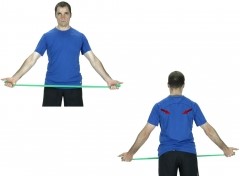
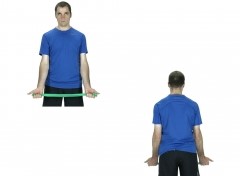
To do this, wrap a band around your hands with your palms facing forward and thumbs pointing out.
Squeeze your shoulder blades back and down as you rotate your arms out and away from your body to bring the thumbs in a hitchhiker position, palms facing out. Make sure the elbows remain fully extended during the exercise. Repeat for 1 minute.
EXERCISE #2: BANDED WALL CLOCK MOVEMENTS

Another great shoulder stability exercise using a band is a wall clock movement with a band around your wrists.
To do this, stand at about an arm reach away from the wall and place your hands on the wall with a band around your wrists. Begin by pushing into the wall so that your shoulder blades are set firmly against your rib cage.
With the right hand first, touch every number of the imaginary clock (12-1-2-3-4-5-6) with the hand on the wall, returning to the centre each time. Repeat the exercise with the left hand (12-11-10-9-8-7-6).
For all of these exercises (and as always) good form is stipulated rather than going for using heavy weights to complete them, higher reps and good form is recommended. Doing these regularly may assist in providing the most optimal shoulder health to you as possible, whilst preventing injury and possibly boosting performance. A definite one to try for any keen tennis player at any level, any age and any stage of training or playing. Try to incorporate these before going onto the court for good shoulder health when playing tennis!
If you’re struggling with a shoulder injury that’s impacting your game, exercise or daily life, call us on 0800 731 2738 or book online here.
You can also view all the services we provide within our clinics on our website, as well as checking out our other blogs and content.
For more free tips and information, make sure to follow our Facebook and Instagram pages. We also post client stories, so you can see how we’ve helped people get back to doing the things they enjoy!
